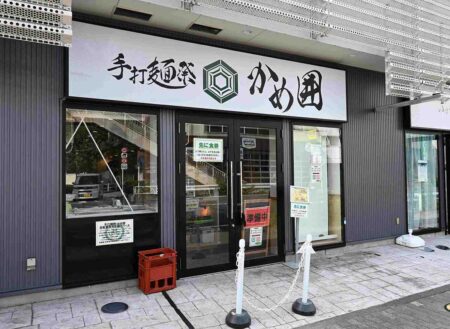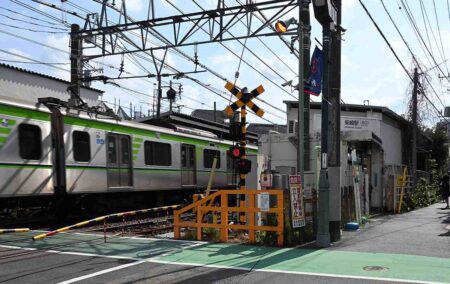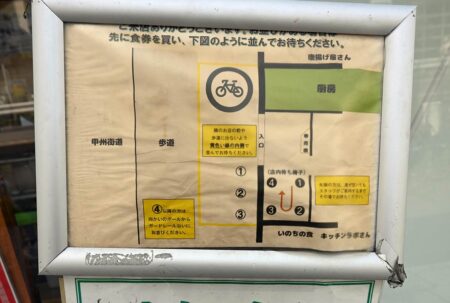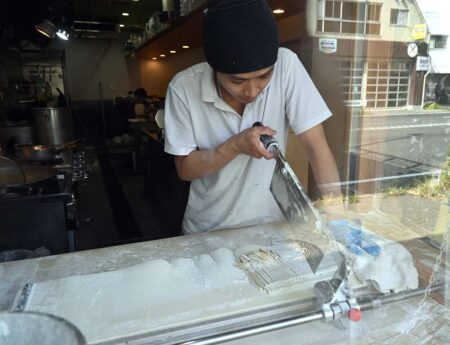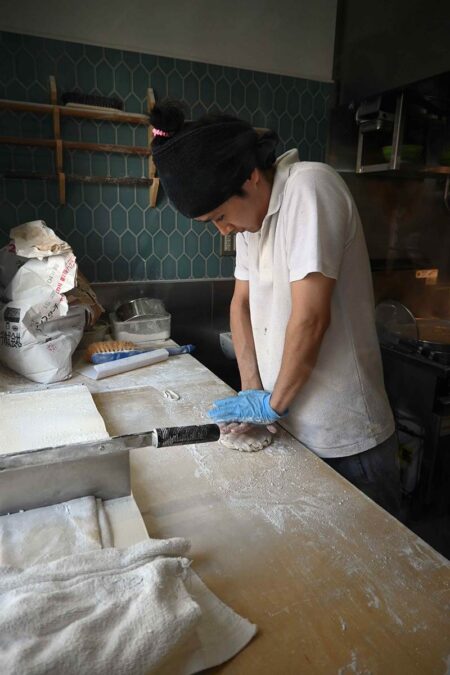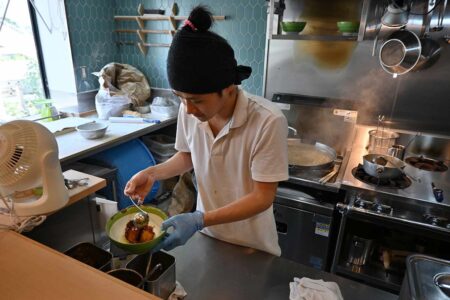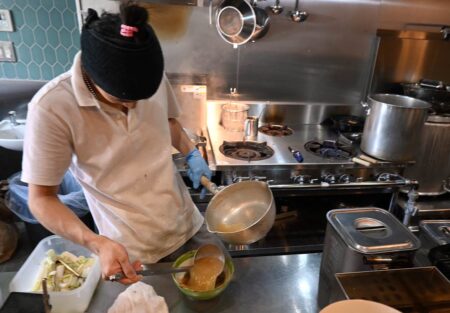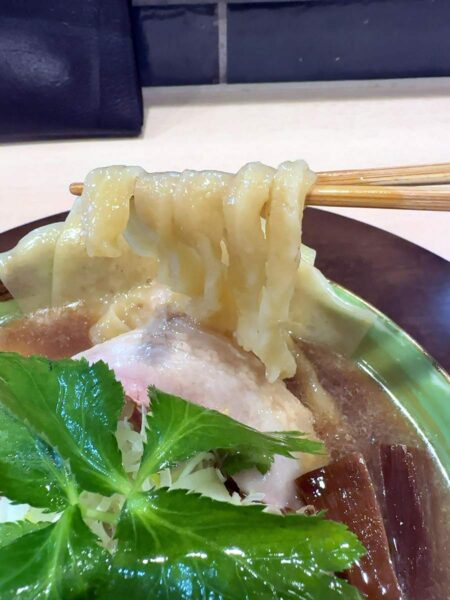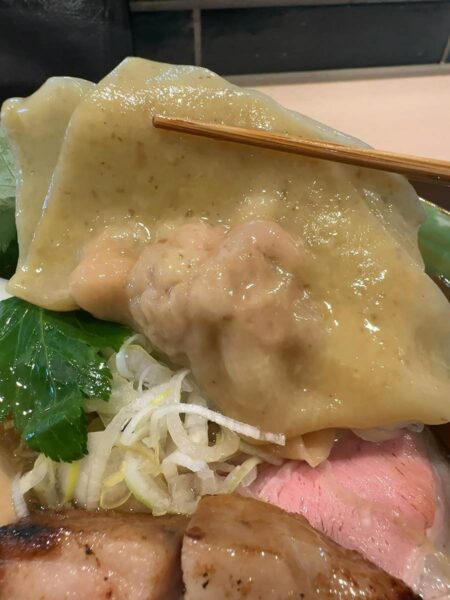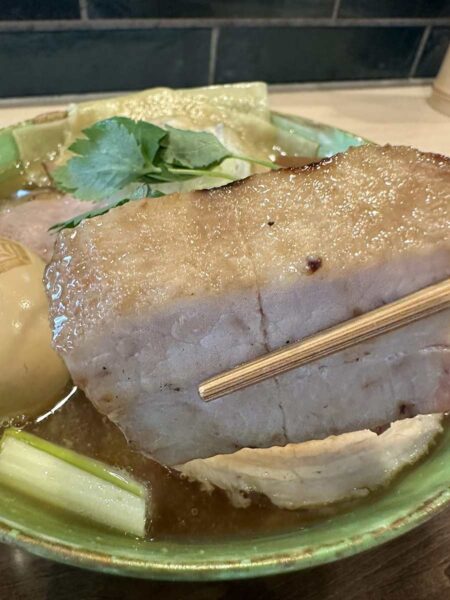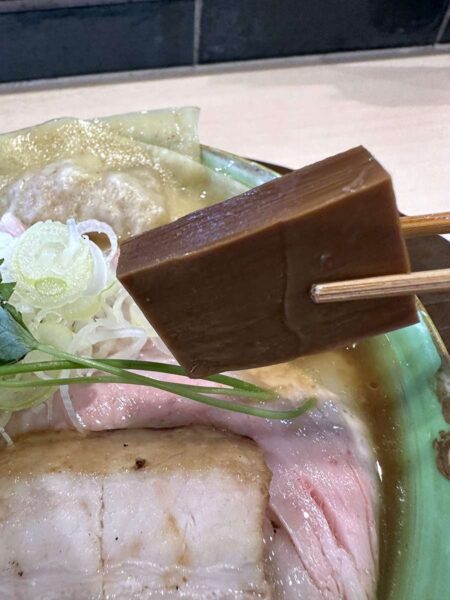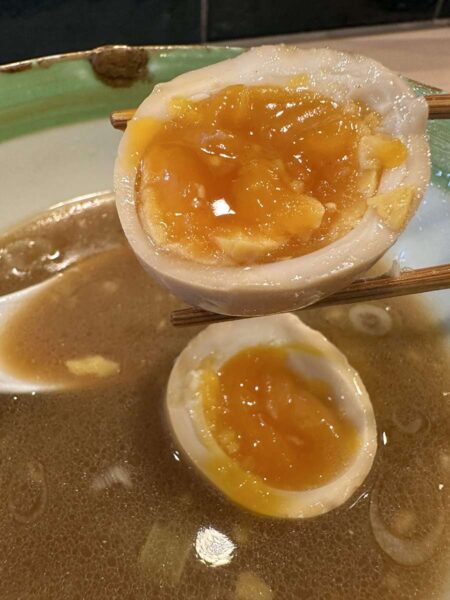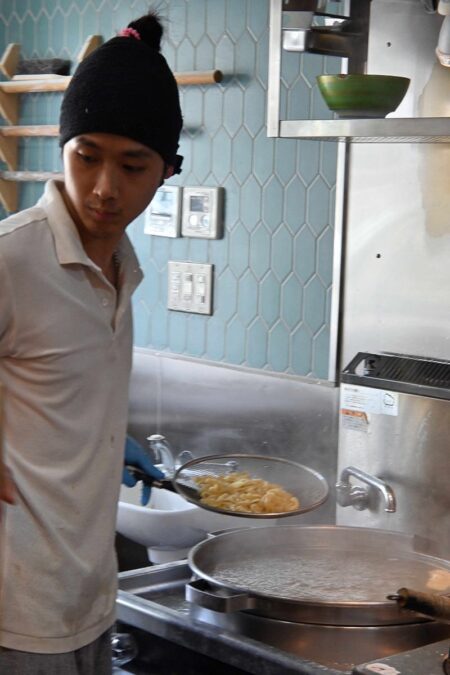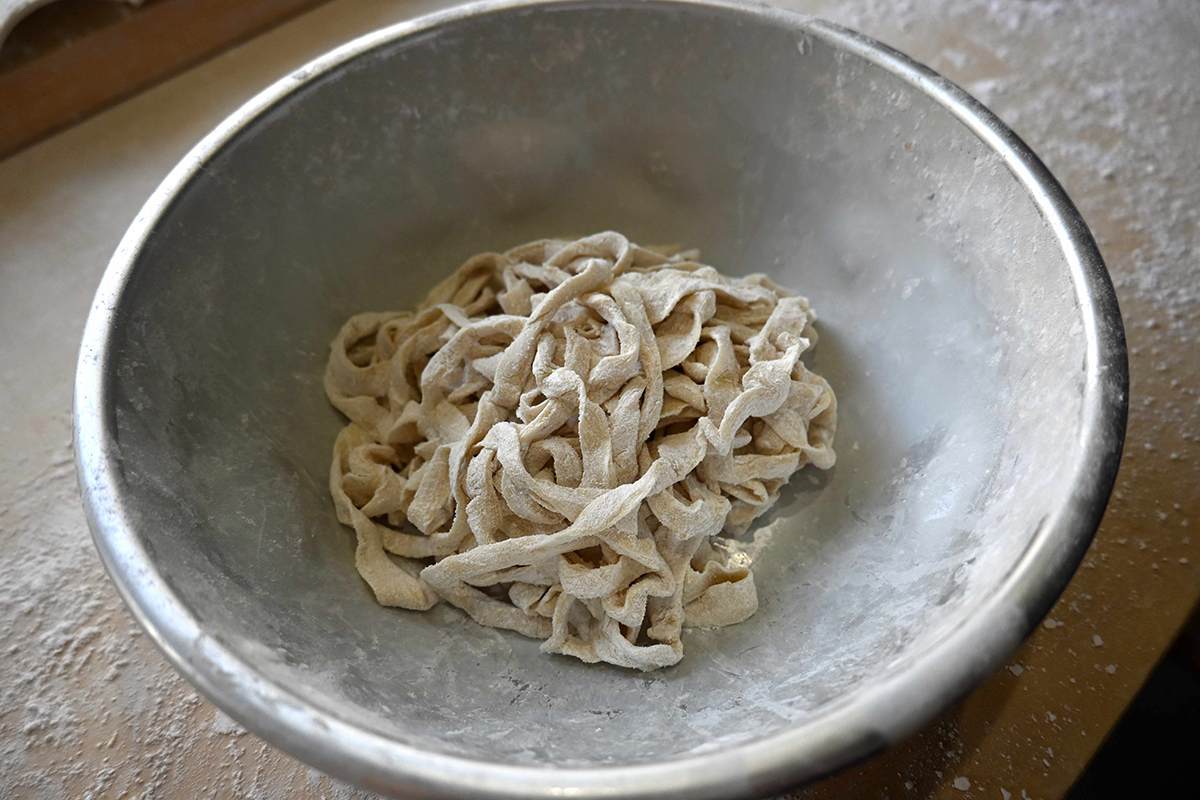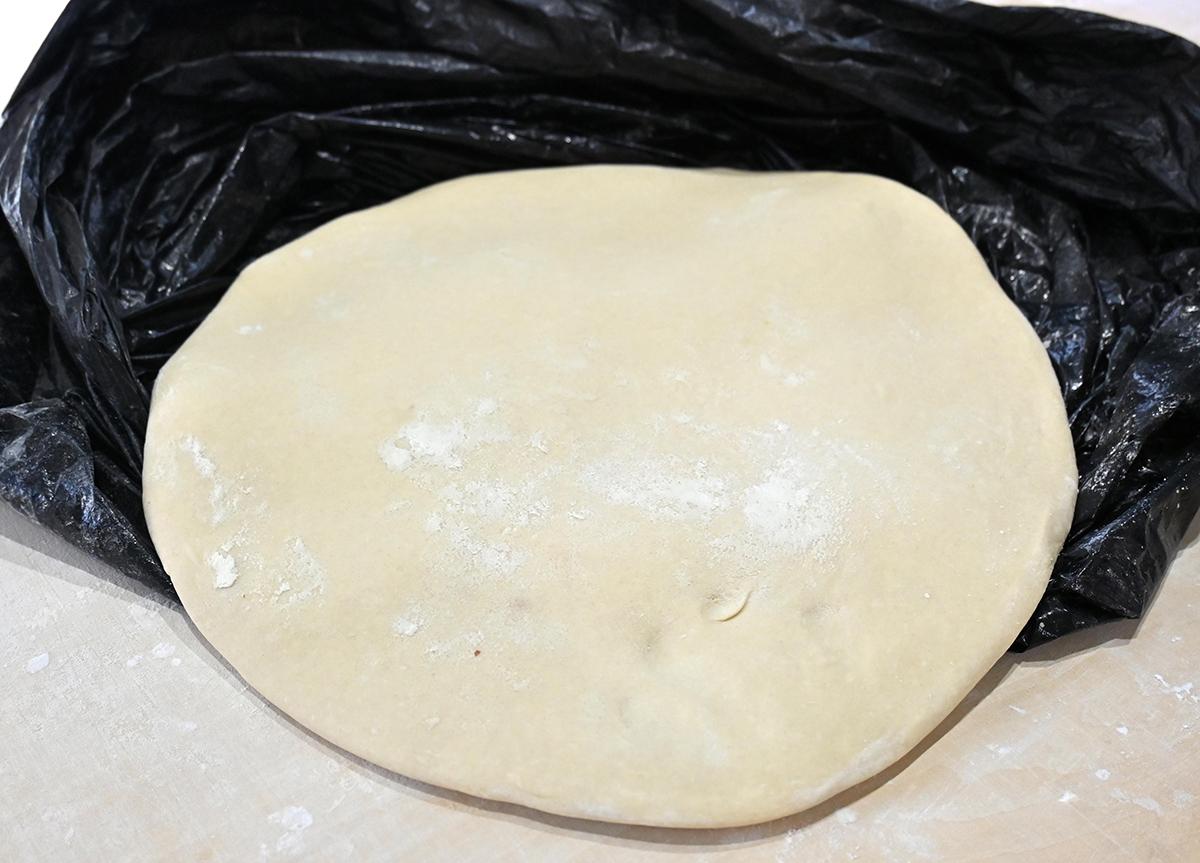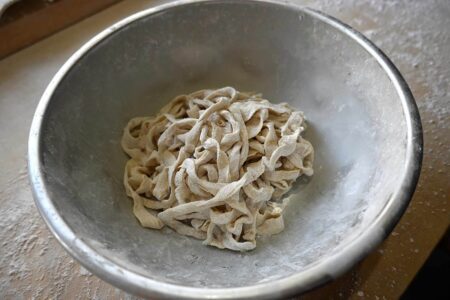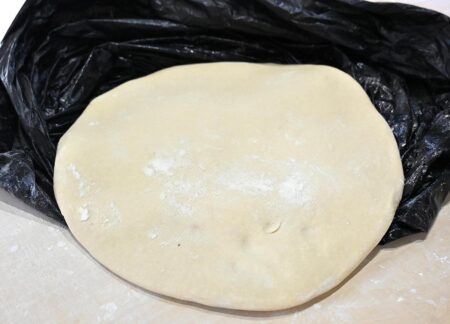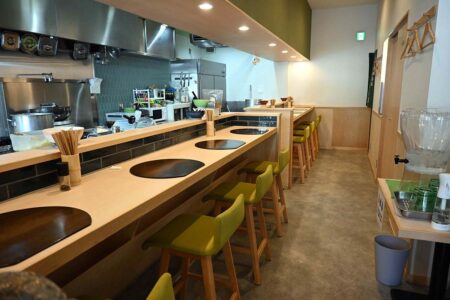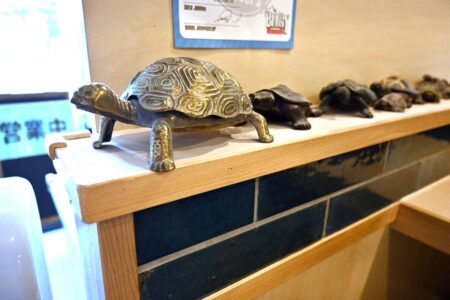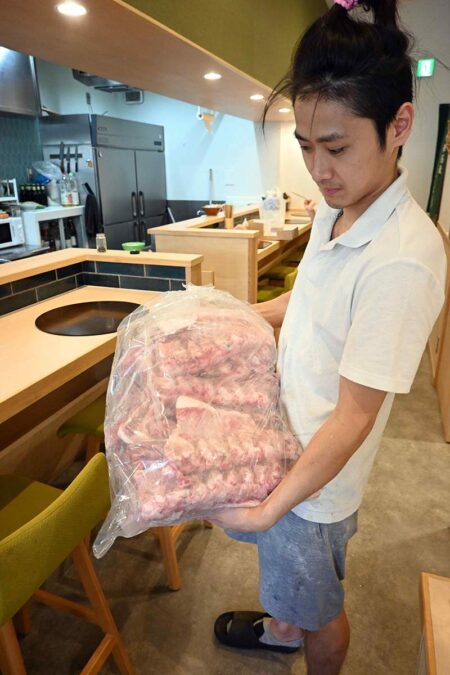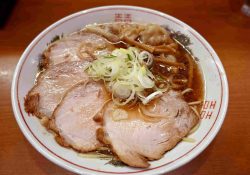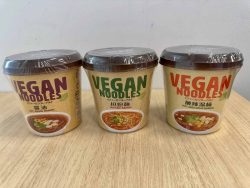
Special handmade chuka soba shoyu (¥1,650)
15:44 JST, August 20, 2024
The sound of noodles being cut echoed through the beautiful ramen shop. It was like background music while I waited for a bowl of ramen to be served.
Teuchi Mensai Kamei in Chofu, Tokyo, specializes in handmade noodles, as the name of the shop suggests – Teuchi means handmade in Japanese.
While noodles made in-shop by a noodle-making machine are relatively common, making noodles by hand is comparatively rare. Moreover, Kamei’s noodles are a hybrid of the best parts of Sanuki udon and ramen. I visited the up-and-coming young owner at his shop.
-
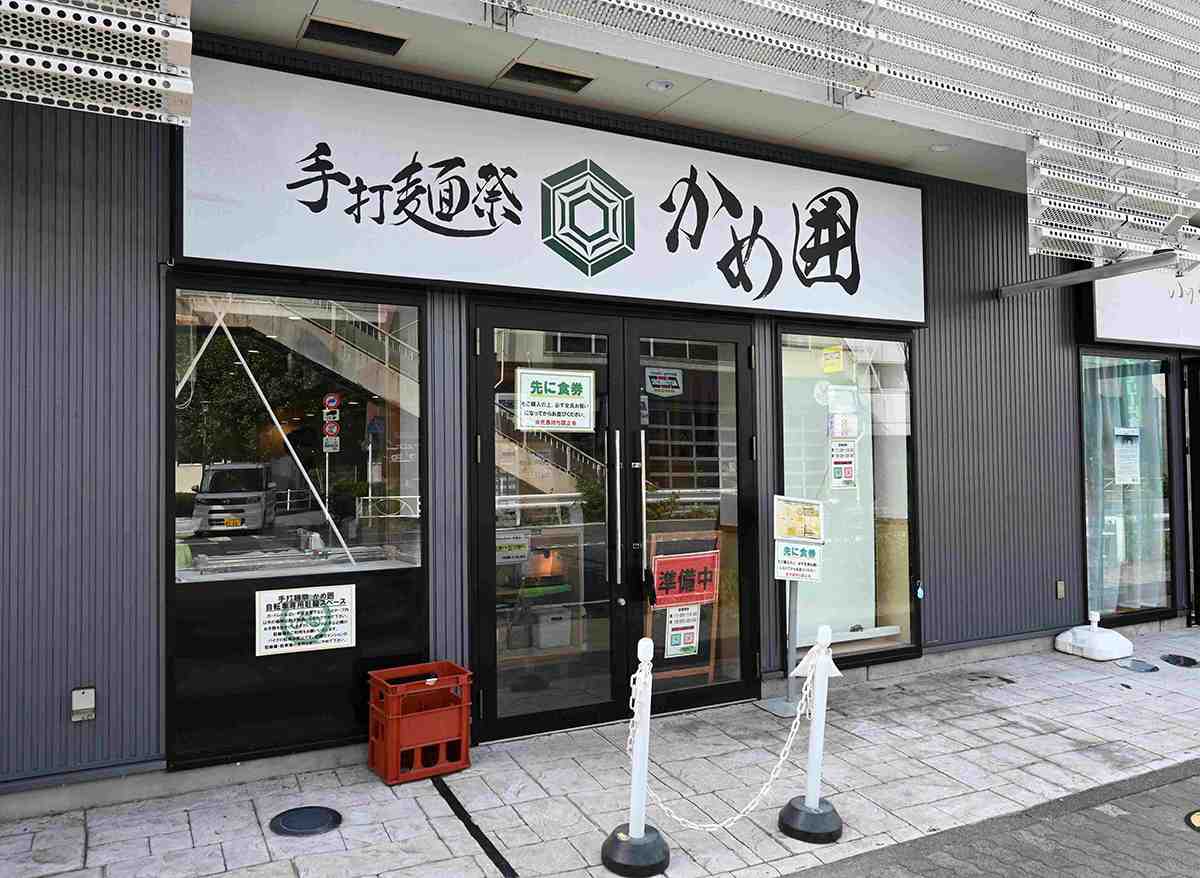
Exterior view of Kamei. The noodle-making space is located behind the window on the left. -
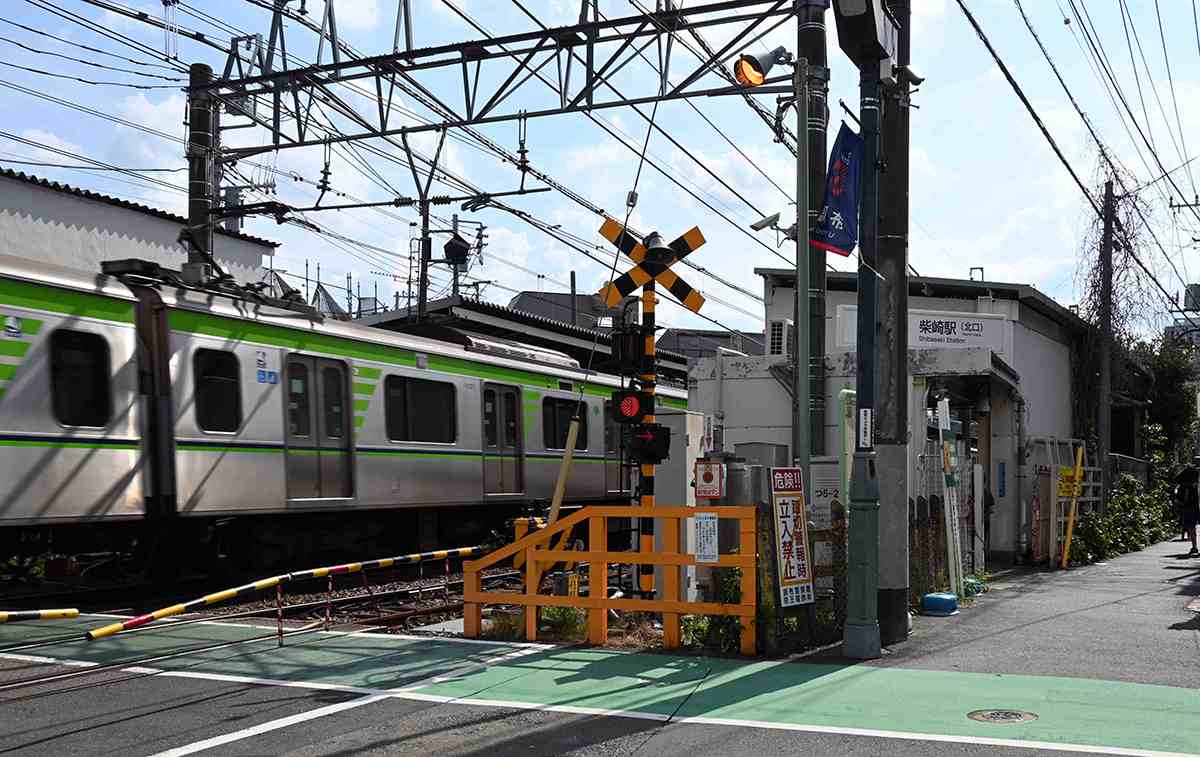
North exit of Shibasaki Station on the Keio Line -
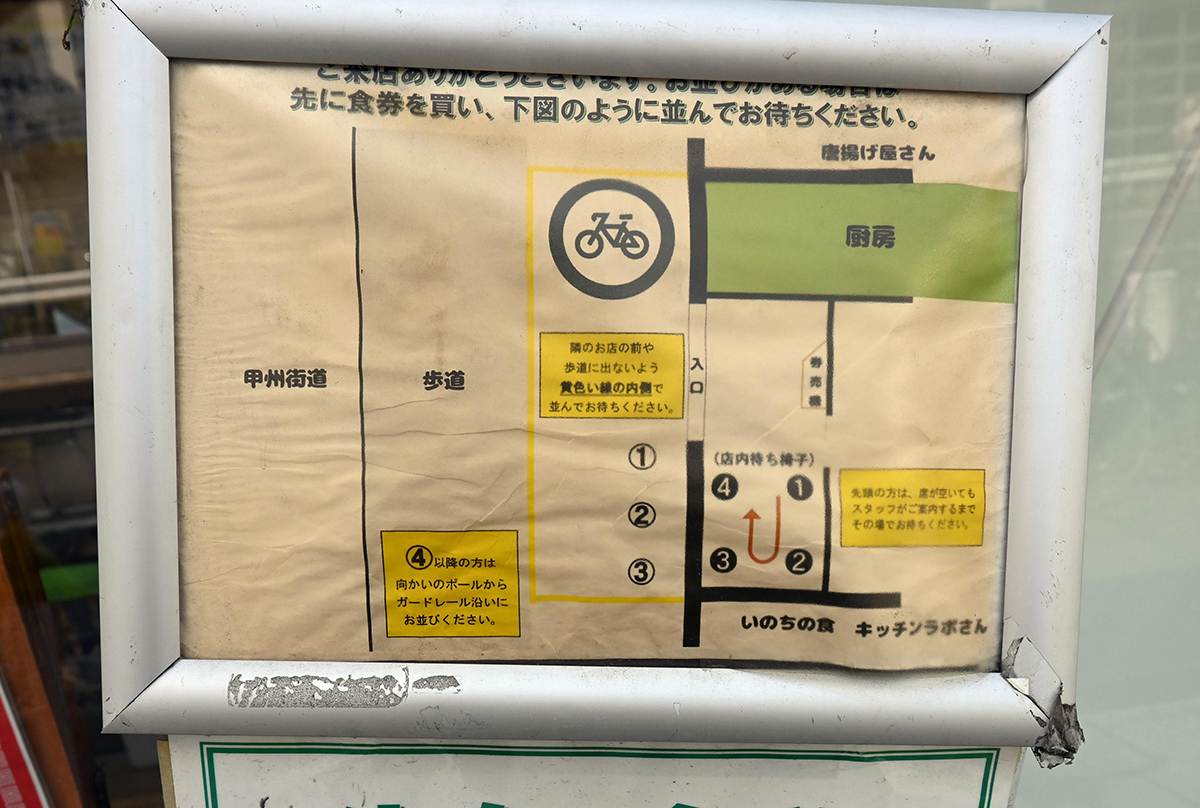
An information board explains how to line up if there are no free seats. -
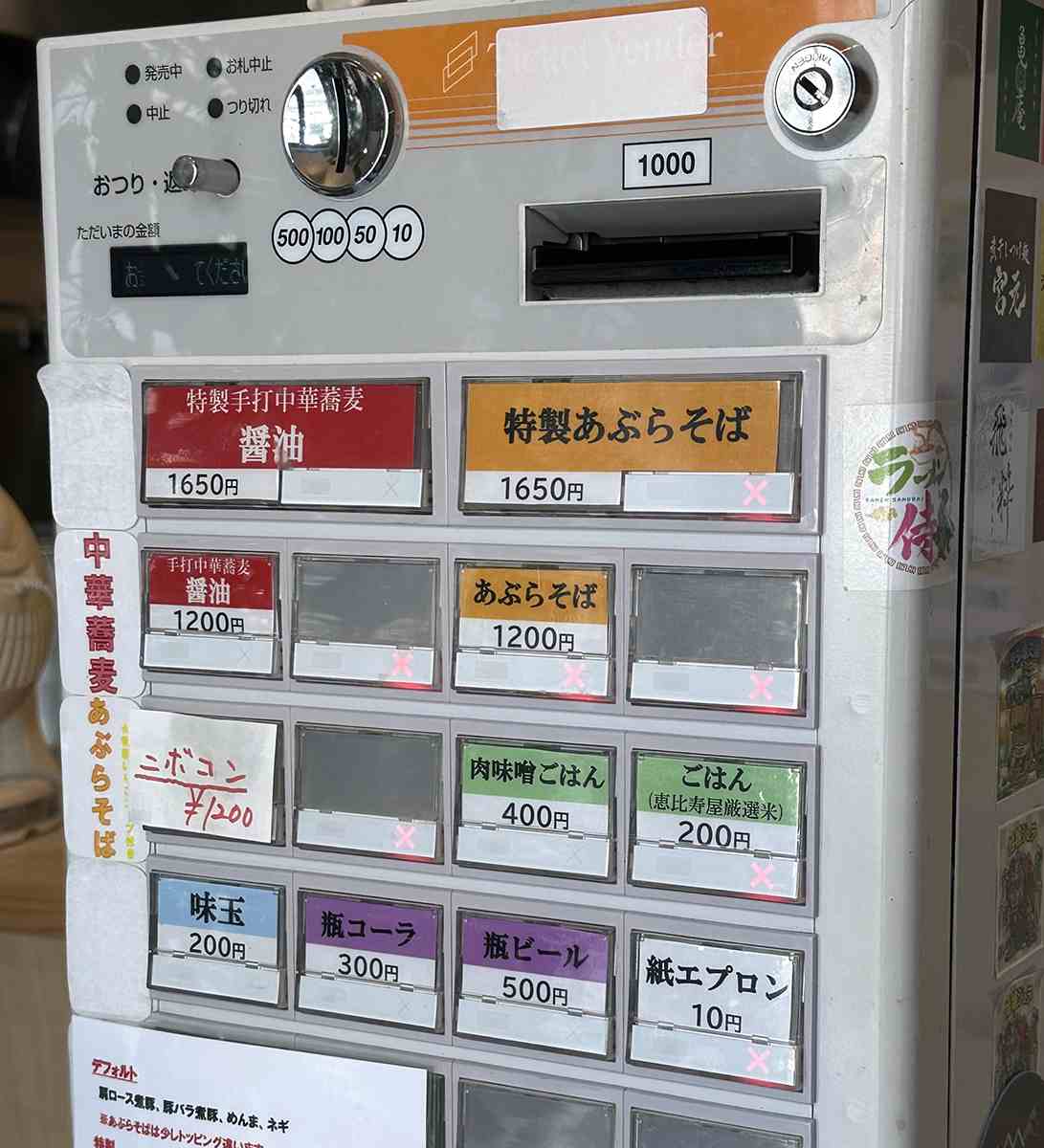
Meal ticket machine
Teuchi Mensai Kamei is only around a four-minute walk from the north exit of Shibasaki Station on the Keio Line. The shop is located on the first floor of a building along Koshu Kaido (National Route 20), with an eye-catching noodle-making space facing the sidewalk. It has been two years and two months since it opened.
Entering the still-new shop, I found the ticket machine right away. There are not many items on the menu. At the time of the interview, there were two types of ramen on offer: “Teuchi chuka soba shoyu (soy sauce)” or “Nibokon” (Abura-soba). I purchased the “Special teuchi chuka soba shoyu” (¥1,650).
I gave my meal ticket to owner Kota Kamei, 27, who greeted me with a smile, and he immediately began to make my order. Kamei said, “I make my noodles the way Sanuki udon are made, so they have a chewy and glutinous texture that you don’t find in regular ramen noodles.”
-
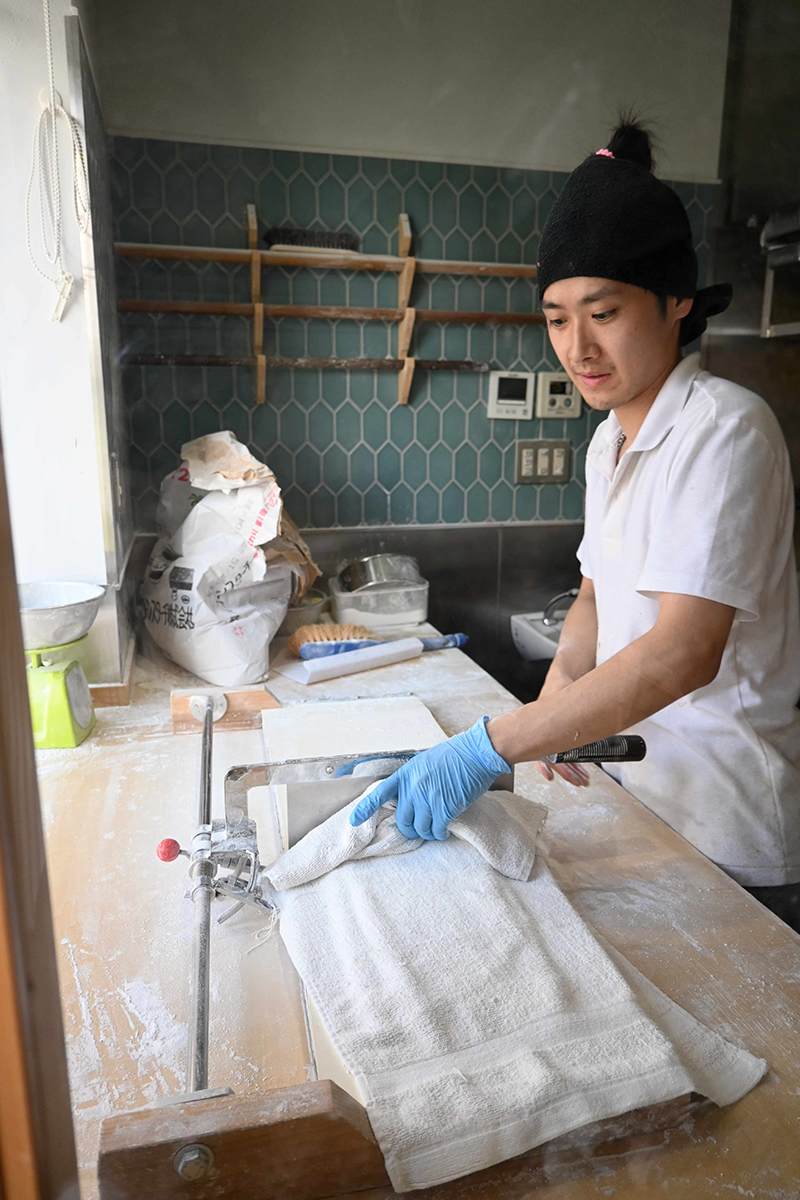
Kamei prepares to cut noodles. -
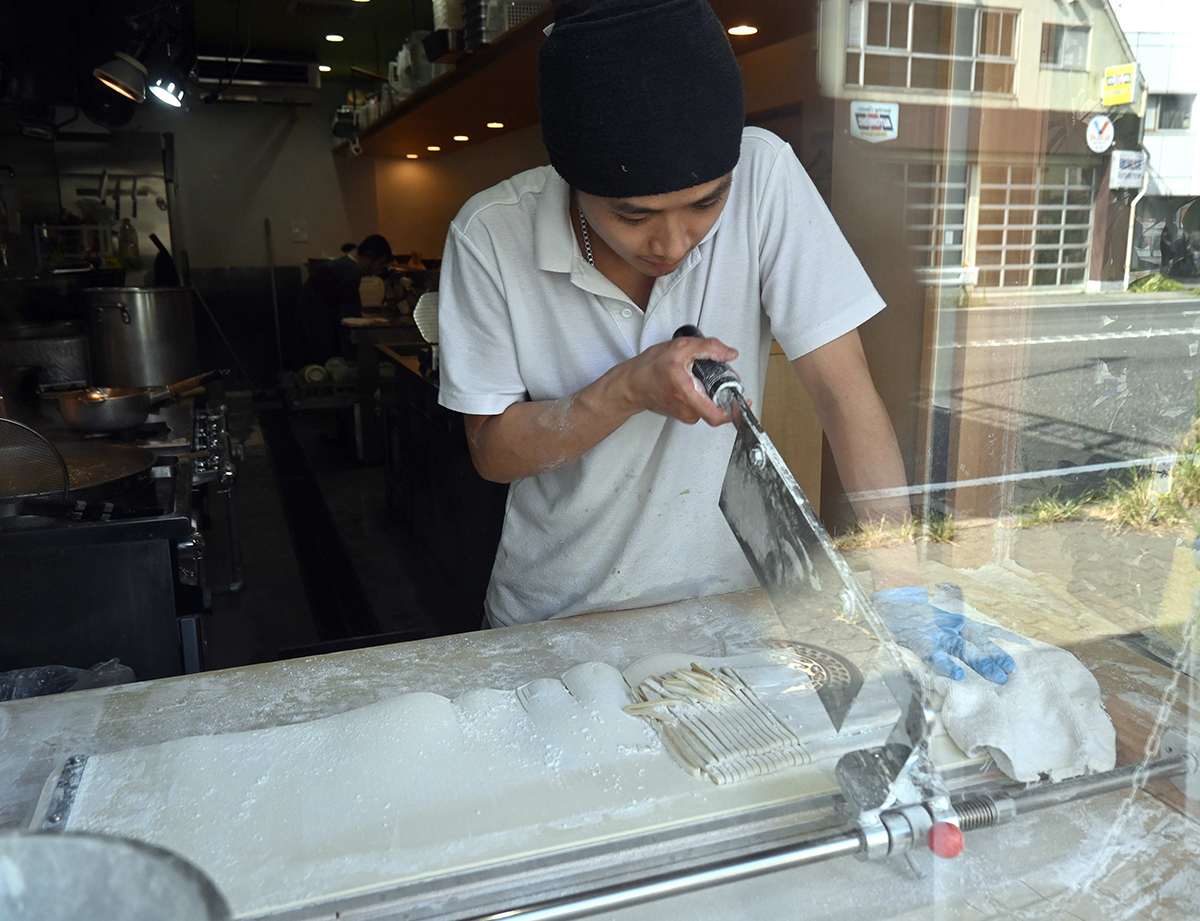
Kamei cuts noodles from dough by hand. -
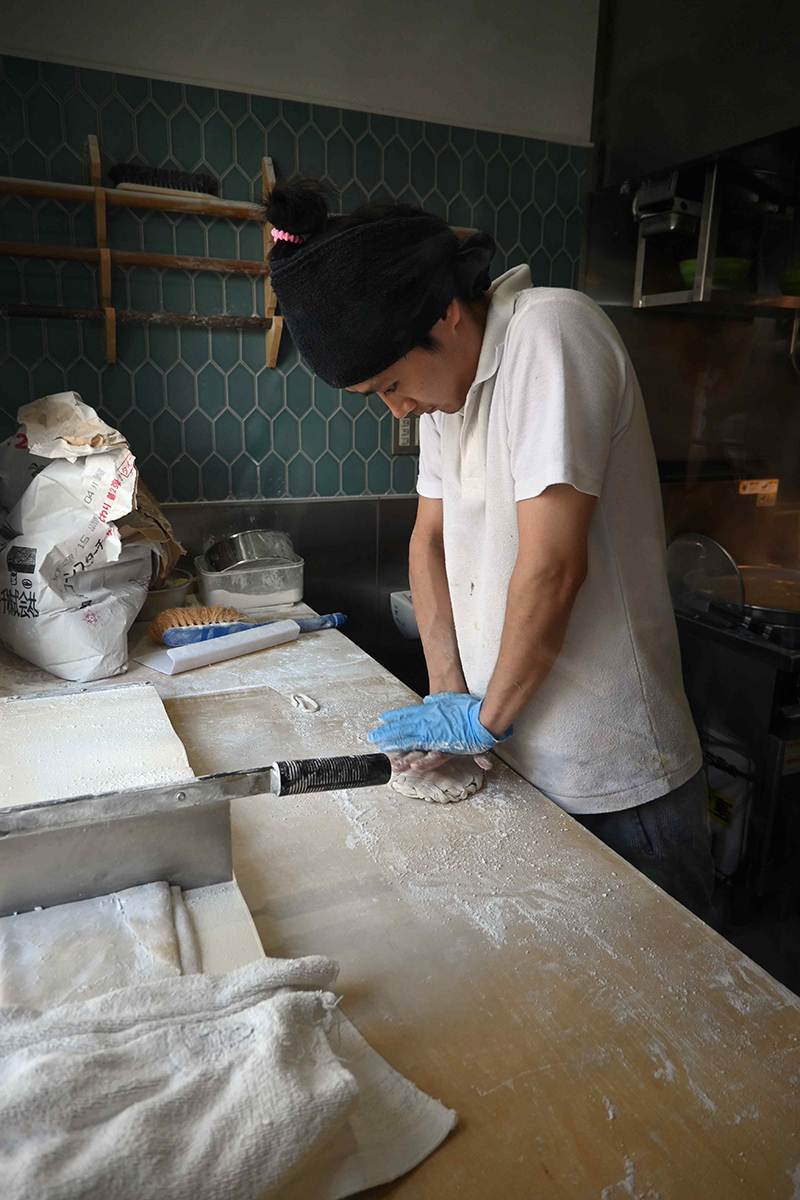
Kamei presses on the noodles with both hand to give the noodles a characteristic curl. -
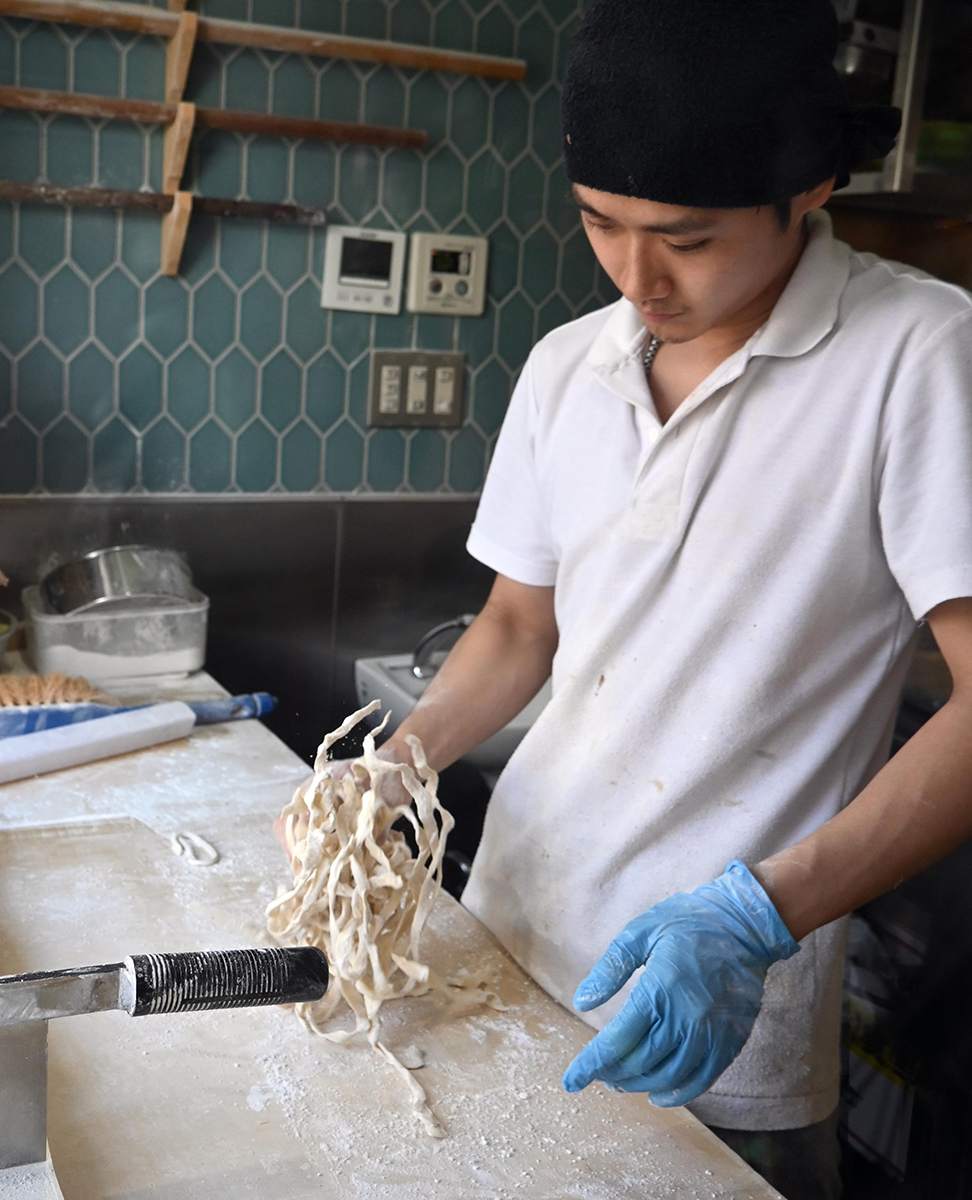
Curly Noodles -
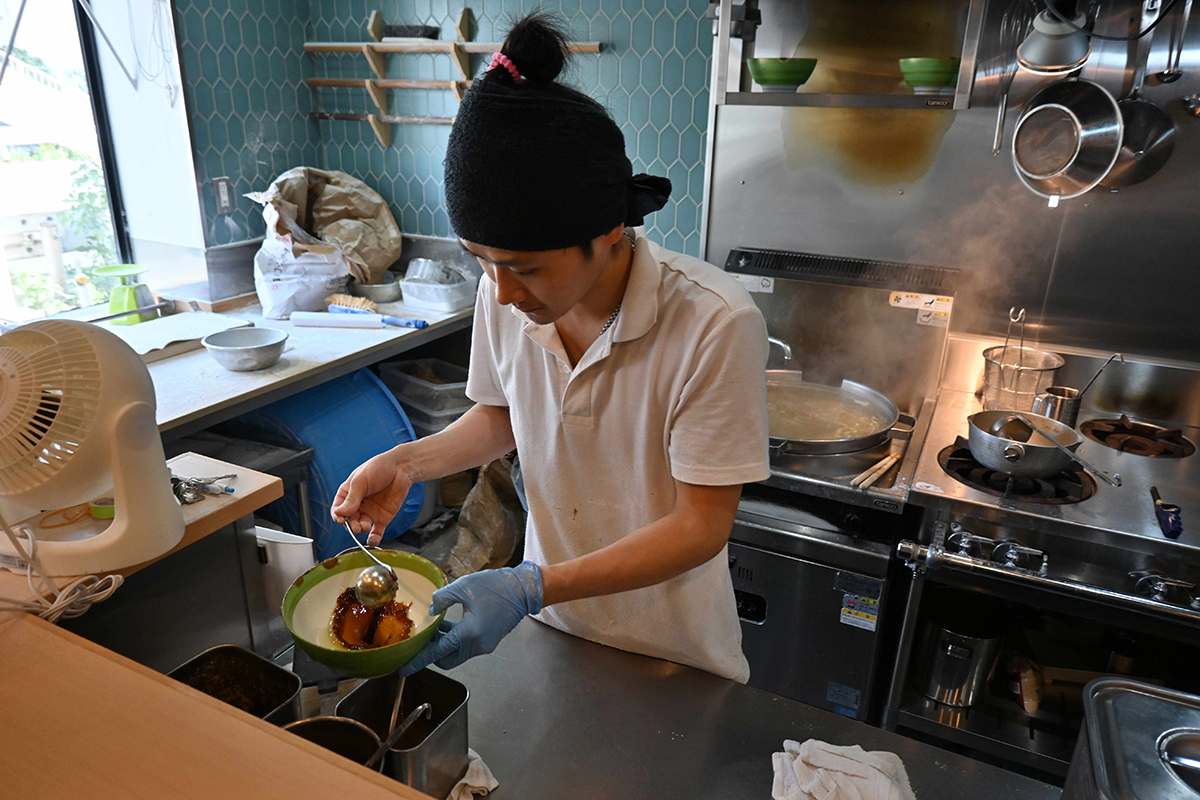
Kamei adds kaeshi sauce to a bowl. -

Kamei pours soup into the bowl. -
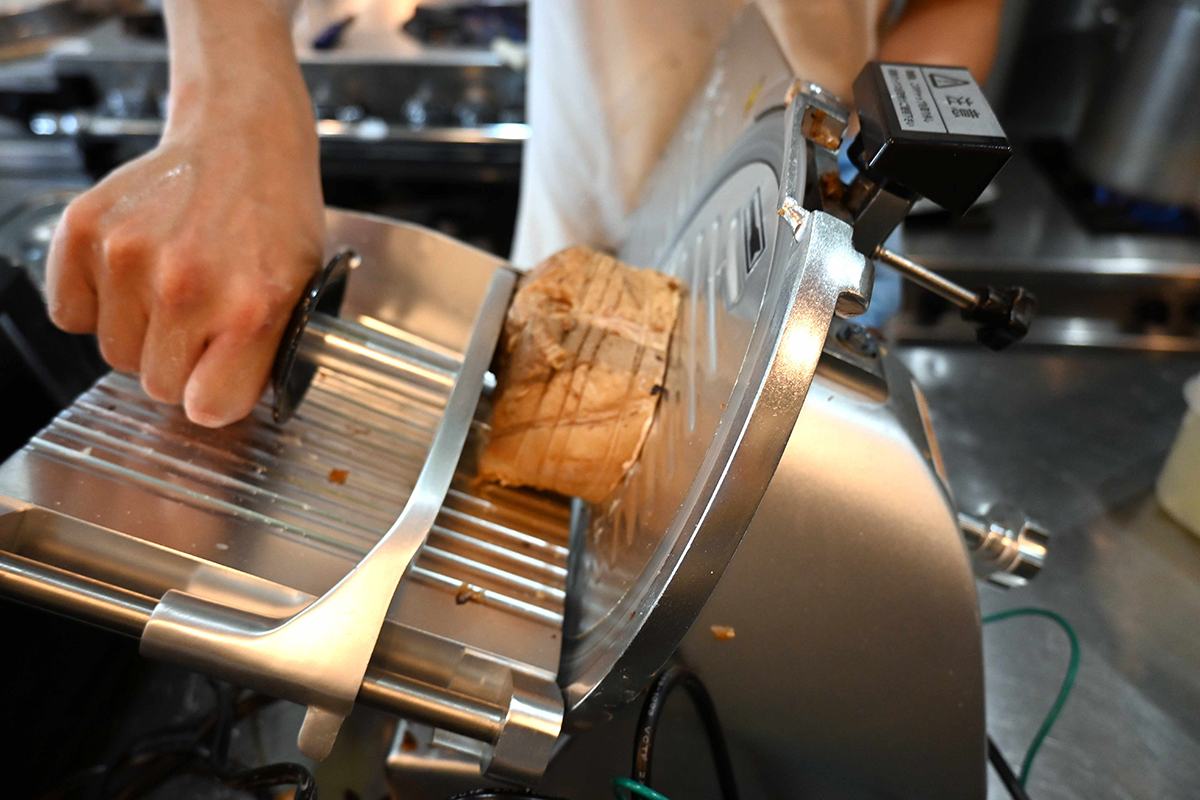
Chashu pork is sliced
In the noodle-making space, Kamei quickly cut the thinly spread dough, using a manual cutter equipped with a blade like a large vegetable knife. When he had cut enough noodles for one serving, he pressed them down several times with both hands to make them curly, and then began boiling them.
The completed ramen looked gorgeous, with a generous helping of toppings which hid the handmade noodles. Overall, there is a slightly smoky aroma, which was very pleasant.
Of course, I had to start with the noodles. They were thick and chunky, indicative of handmade noodles, and were also noticeably fresh and moist. They certainly had the glutinous texture Kamei had mentioned. When I slurped up the noodles, I found that the mild, yet rich-tasting soup clung well to the thick noodles.
-
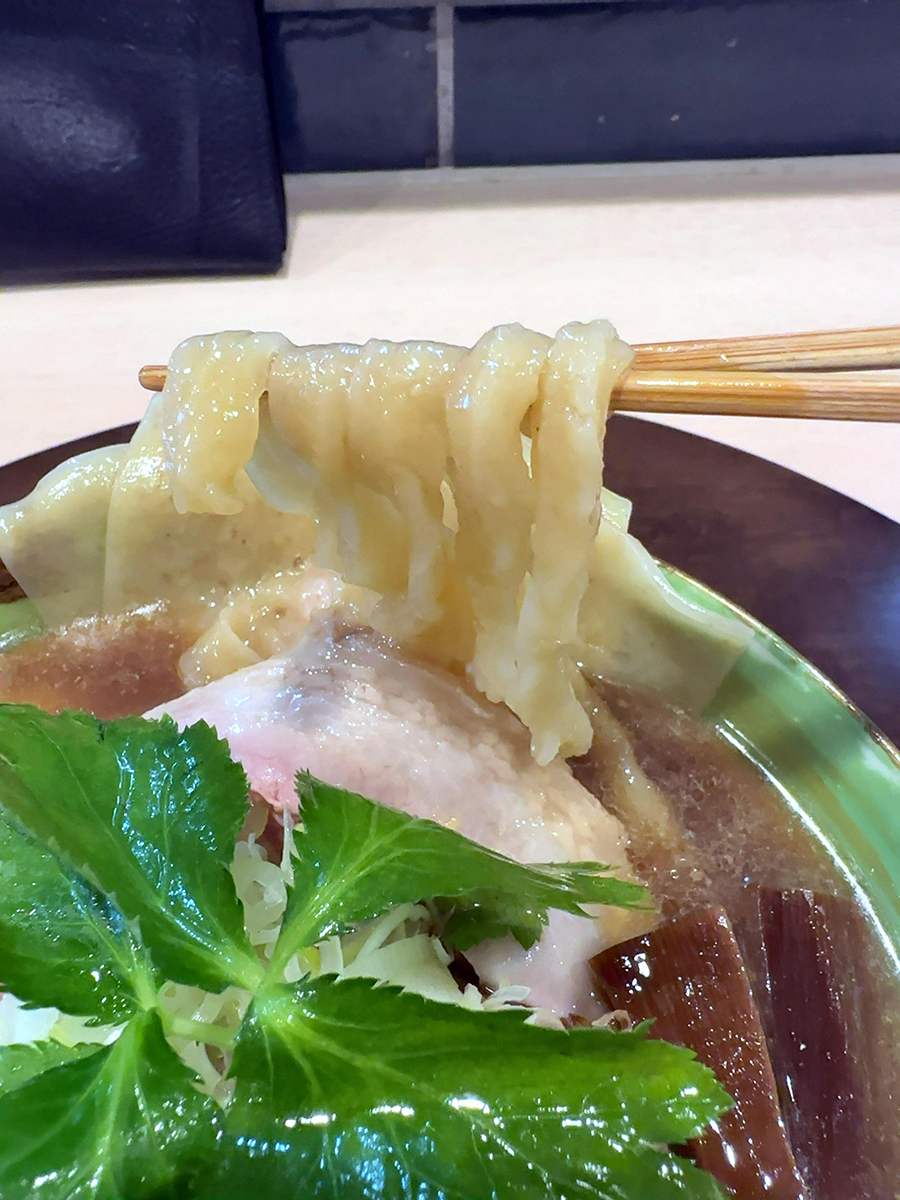
Handmade thick noodles -
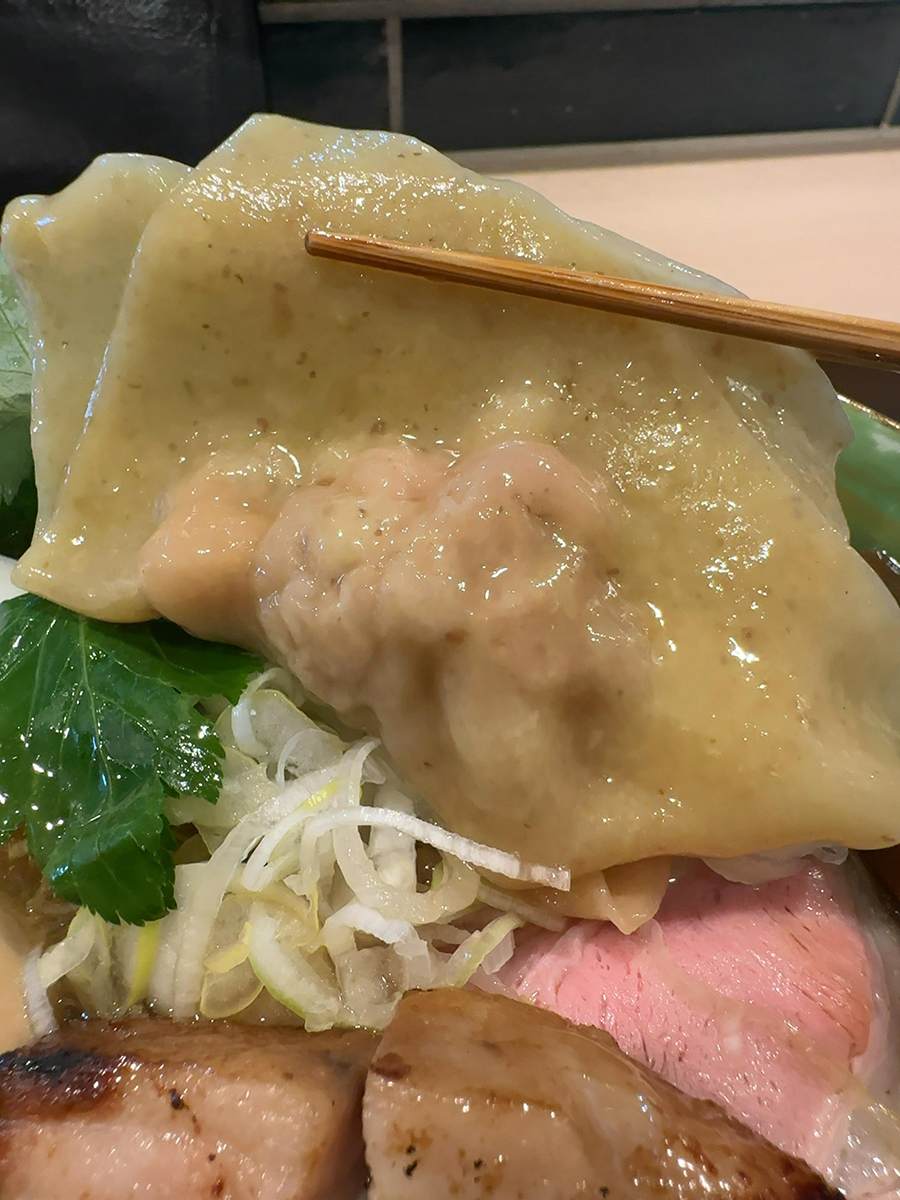
Handmade wontons -
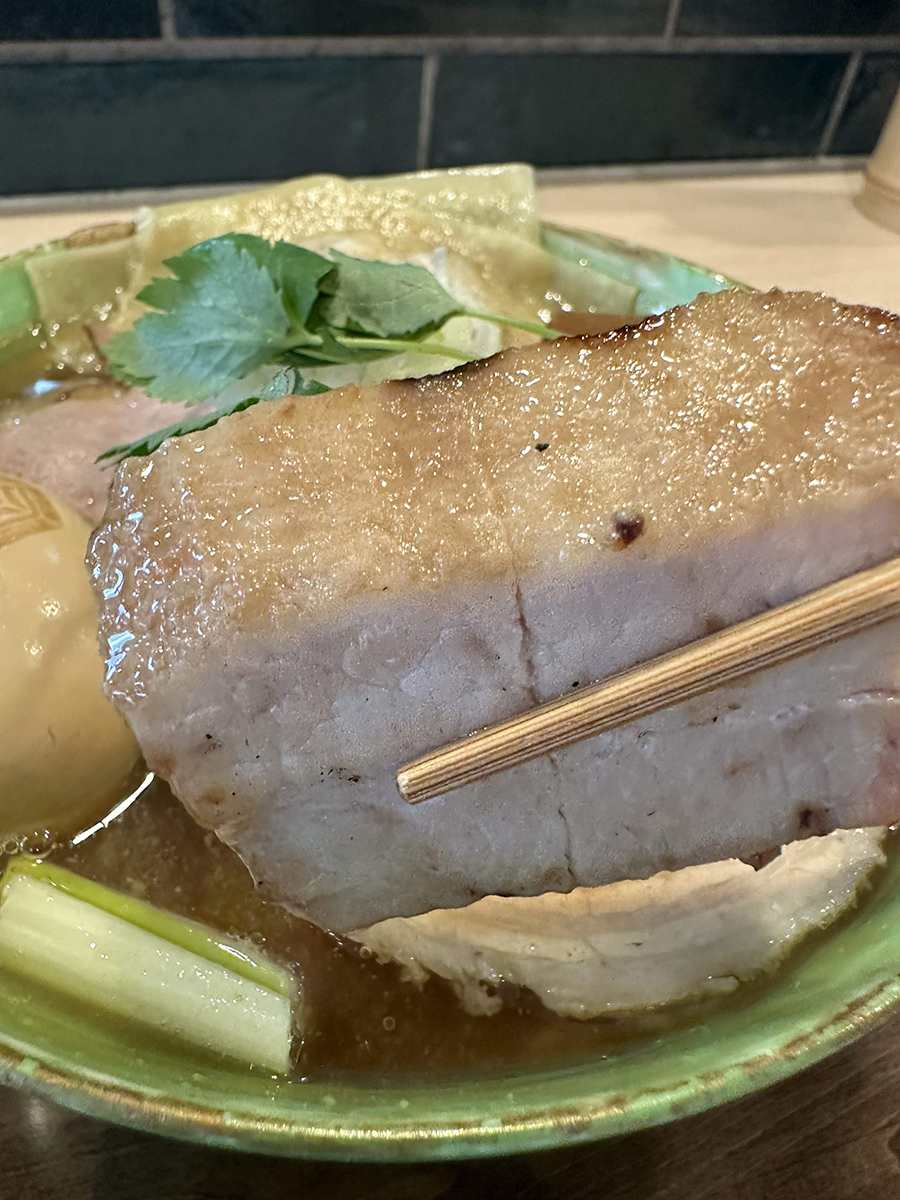
A thick slice of broiled pork belly chashu. -
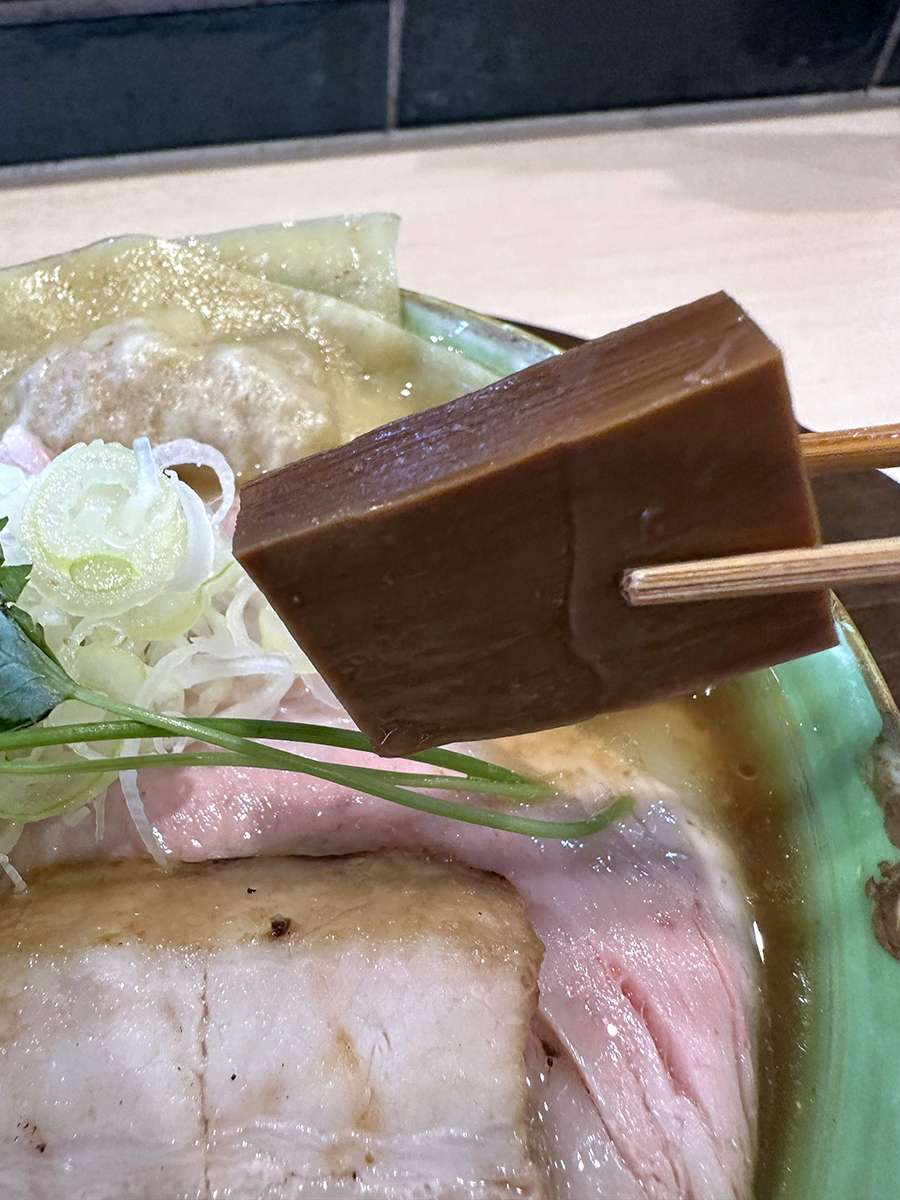
Tender homemade menma is made over a period of 8 days. -
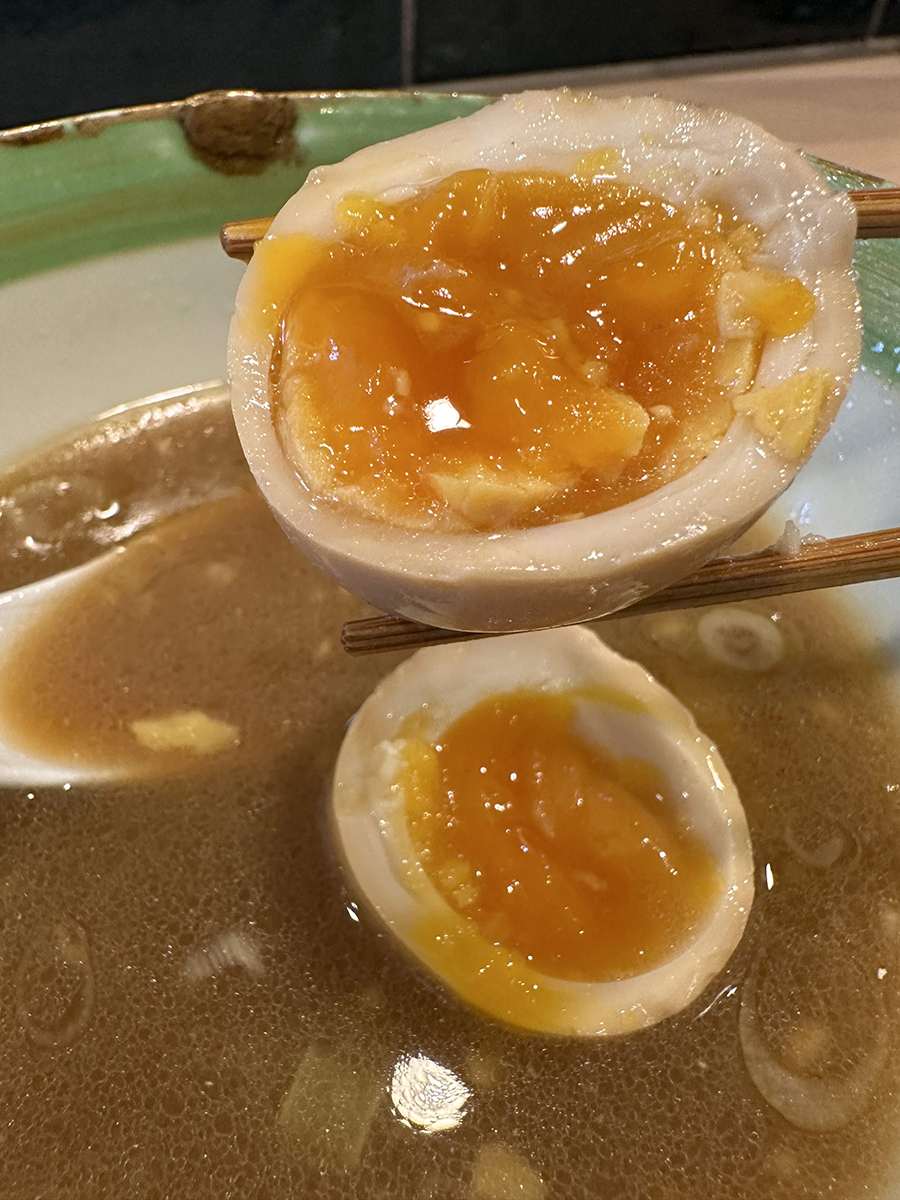
Ajitama seasoned egg with jammy yolk -
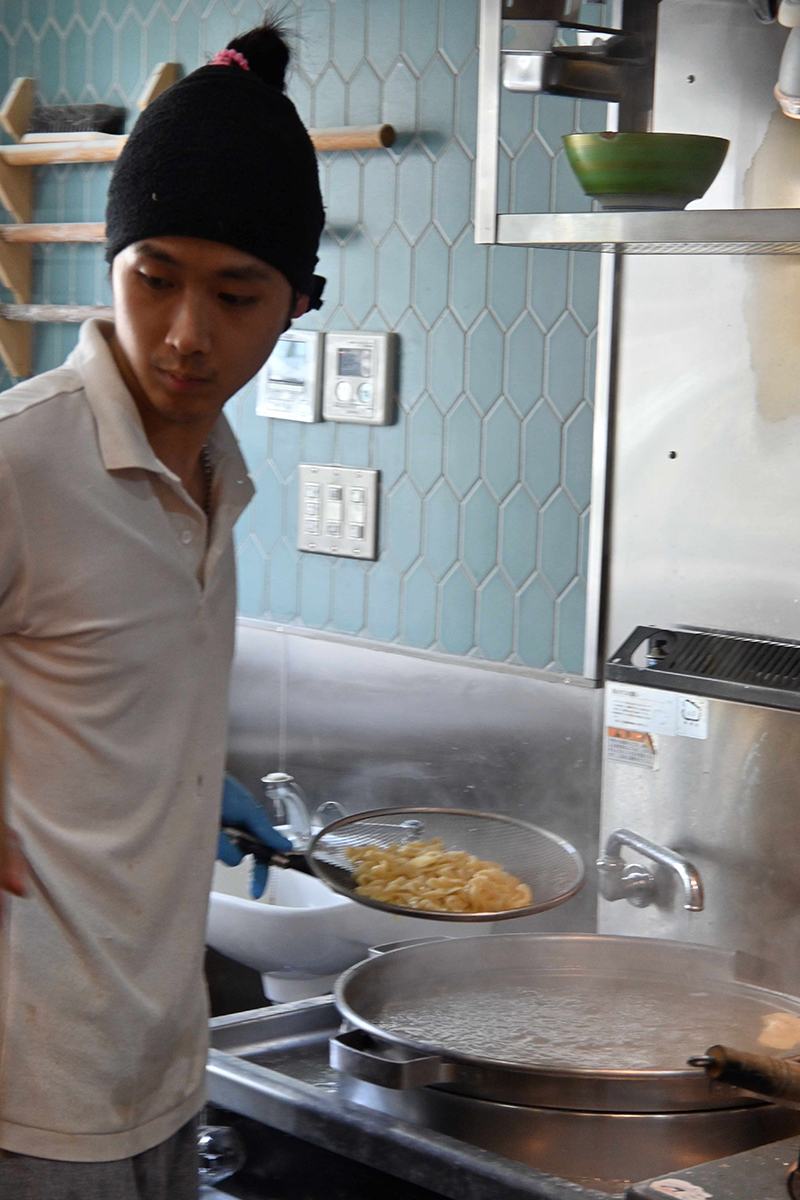
Noodles are removed from boiling water
The soup is made from the combination of a pork and chicken broth with a fish-based broth. Kamei explains, “I make the flavor, texture and aroma of the soup thick so that it is in harmony with noodles.” The oil paired with the soup is made from pork and chicken, to which the aroma of dried fish and vegetables is added. The kaeshi sauce is a blend of the sauce used to make the shop’s boiled pork chashu and light soy sauce infused with the fish flavor. The synergy between the oil and kaeshi sauce further enhances the depth of the soup and gives it a unique aroma and flavor.
The regular “Teuchi chuka soba shoyu” is topped with a slice of both pork shoulder chashu and pork belly chashu, green onions, and homemade menma pickled bamboo shoots. The thick menma are made over a period of eight days, and they are soft and easy to eat. The “Special” version adds a slice pork belly chashu which is broiled just before serving, an ajitama seasoned egg, and homemade wontons. I enjoyed the noodles, which were the main attraction, and the soup and toppings supported them perfectly.
Touring ramen shops
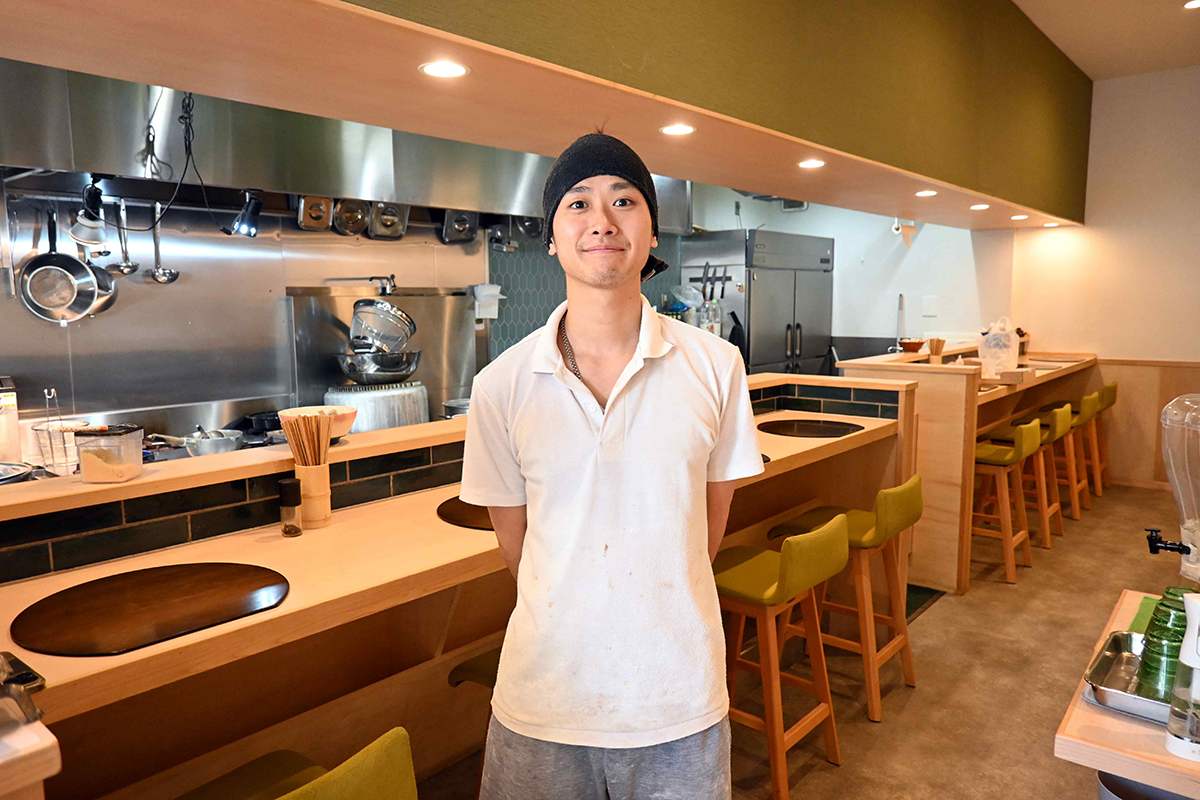
Kota Kamei, owner of ramen shop Kamei
“I think the best tasting noodle is Sanuki udon when you eat just the noodle without anything else on it. That is why I aimed to create a ramen that incorporates its essence,” Kamei explained.
The noodles, of which he is very proud, are made with a blend of four or five types of flour, including a wheat flour called “Menmatsuri” that is usually used for udon noodles and flour from Hokkaido or Australia. But the noodles he makes are not udon noodles because an alkaline salt solution typically used for making Chinese noodles is used and the noodles become curly.
Kamei makes the dough for the noodles every morning before the shop opens and uses it up that day. Flour and water are put into a large blue bucket, kneaded, and then divided into chunks. After an hour in a room to proof, the dough is taken out and kneaded into a round cushion-like shape through a process called “Kiku-momi,” which removes the air from the dough. Once an order is received, the noodles are cut from the dough. Kamei says, “It’s a physical workout; 100 servings a day is my limit.”
However, he is confident in his physical strength. In high school, he was a long-distance runner on the track team.
In his third year of high school, he happened to eat abura-soba in Yokohama. Abura-soba is a type of ramen in which the noodles are served without broth and instead mixed with a special sauce. He was so impressed that he started eating abura-soba on a regular basis, and eventually branched out to ramen. In order to save money on train fares, he walked about 70 kilometers from his hometown of Odawara, Kanagawa Prefecture, to a ramen restaurant in Tokyo’s Kamata district, then walked to other ramen shops in central Tokyo and finally returned by train.
“When I went to Kamata, I would usually leave around 3 or 4 a.m. and arrive there around noon. Money that my parents gave me to buy a commuter pass was instead used to pay for ramen,” Kamei recalled happily.
Later, although he entered university, his passion for ramen grew stronger and stronger, and he began working part-time at Miyamoto, a ramen shop in Kamata famous for its niboshi tsukemen. He had a dream of opening his own ramen shop in the future, and the owner nurtured his abilities. He left college before his junior year to give his all to achieving his dream. His father is a police officer and his mother a nurse – they as well as other relatives were very opposed to the idea.
“I asked myself thousands of times whether or not I could really run the shop, and I came to the conclusion that I could,” Kamei said. After that, he became a full-time employee of Miyamoto for four years. Finally, after also managing a pop-up ramen shop at Miyamoto, he set up Kamei at its current location in June 2022.
-
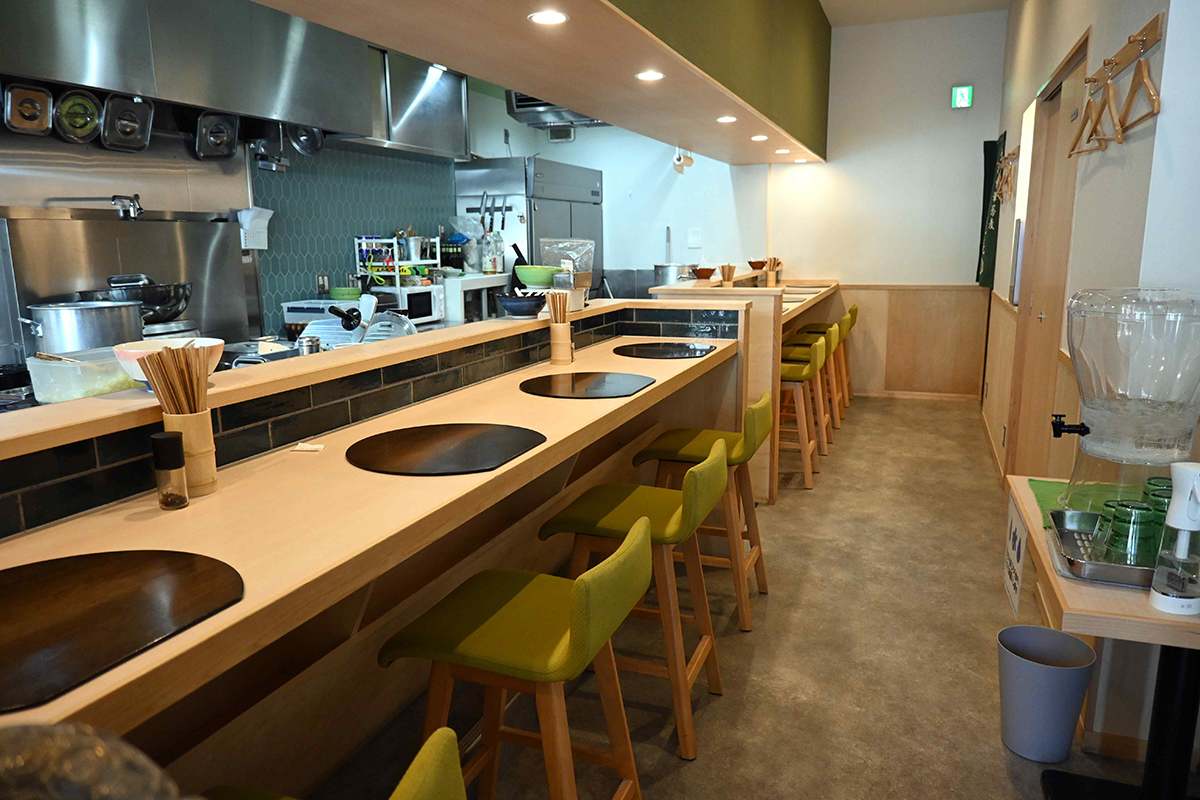
Elegant interior with 8 counter seats. The kitchen and seating area are at the same level. -

Turtles are a symbol of longevity in Japan. Turtle ornaments are placed around the shop to wish the business a long and successful life. -
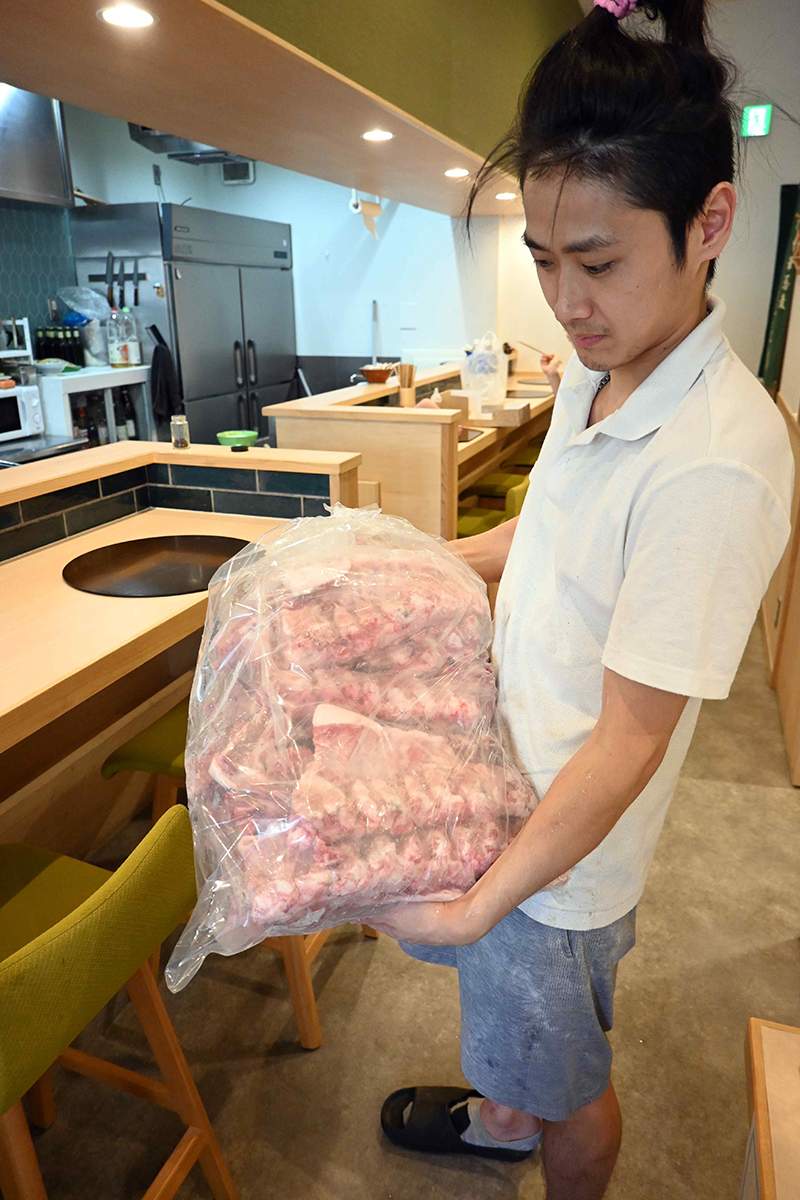
Pork bones used in the shop’s broth
He met his now wife Jura, 27, who was a customer of his while he was working at Miyamoto. Their son was born earlier this year.
Kamei said, “I would like to continue to operate this shop for a long time, and if there is a chance someday, I would like to expand my business overseas as well.”

Teuchi Mensai Kamei
1-55-1 Kikunodai, Chofu, Tokyo. Open 11:00 a.m. to 2:30 p.m. for lunch and 6:00 p.m. to 8:00 p.m. for dinner. Closed on Tuesdays and Wednesdays. For the latest information, please visit the restaurant’s official X: https://x.com/mensaikamei
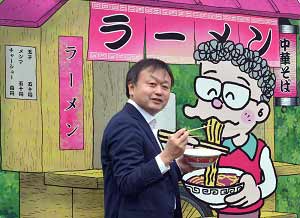
Futoshi Mori, Japan News Senior Writer
Food is a passion. It’s a serious battle for both the cook and the diner. There are many ramen restaurants in Japan that have a tremendous passion for ramen and I’d like to introduce to you some of these passionate establishments, making the best of my experience of enjoying cuisine from both Japan and around the world.
Japanese version
【ラーメンは芸術だ!】東京・調布の「かめ囲」、新進気鋭の店主が作る讃岐うどんとのハイブリッドラーメン

"JN Specialities" POPULAR ARTICLE
-

The Japan News / Weekly Edition (12/12-12/18)
-

English-language Kabuki, Kyogen Entertain Audiences in Tokyo; Portland State University Professor Emeritus, Graduates Perform
-

Noodle Dining Shunsai / Rich Oyster Ramen to Savor at Odasaga; Experienced 68-year-old Owner Creates Numerous Ramen Varieties
-

The Japan News / Weekly Edition (12/5-12/11)
-

People Keep Loved Ones’ Ashes Close in Special Jewelry, Small Urns as Unique Way to Memorialize Them
JN ACCESS RANKING
-

Keidanren Chairman Yoshinobu Tsutsui Visits Kashiwazaki-Kariwa Nuclear Power Plant; Inspects New Emergency Safety System
-

Imports of Rare Earths from China Facing Delays, May Be Caused by Deterioration of Japan-China Relations
-

University of Tokyo Professor Discusses Japanese Economic Security in Interview Ahead of Forum
-

Japan Pulls out of Vietnam Nuclear Project, Complicating Hanoi’s Power Plans
-

Govt Aims to Expand NISA Program Lineup, Abolish Age Restriction
